Dr. Roberta Bondar likes to work in space, both in the field of science as well as with her photographs.
The Canadian astronaut was in Barrie on Monday to donate eight of her landscape photographs to Royal Victoria Regional Health Centre (RVH) through the Roberta Bondar Foundation.
Bondar’s photos will be on display in the Barrie hospital’s David McCullough Hearts and Minds Gallery, located near the main entrance, for the next several months, at which point they will become part of RVH’s permanent collection. Items in the hospital’s collection are on display throughout the facility as part of its Art@RVH program.
Bondar, a 72-year-old Sault Ste. Marie native, was the first neurologist in space and was a pioneer in the area of space medicine, researching blood flow in the brain during microgravity as well as lower-body negative pressure.
According to the Canadian Space Agency, Bondar flew on Discovery for Mission STS-42, Jan. 22-30, 1992. She left the CSA in September 1992 to pursue her research.
But she’s also professionally trained as a nature and landscape photographer.
“On my space flight, I was trained on 13 different camera types, including IMAX, and before that I had cameras my whole life and was always using them for science,” Bondar said. “But I was always trying to get my science to look more artsy.”
Bondar says she sees photography as the “bridge” between science and art.
“I’ve always been able to bring technology to aid me with what I want to do in both art and science,” she said.
In the “old days” before digital photography, Bondar said the first thing that would come off the Space Shuttle when it landed was the bag of film, “because it was more important than the astronauts,” she quipped, adding the images from space remain the most important aspect of a mission.
After seeing the Earth from space and photographing it, Bondar said when she planted her feet back on the ground she wanted to photograph all of Canada’s national parks to give Canadians “a better sense of who we are.”
Bondar’s landscape photography has been shown in several galleries and published in numerous books.
Her favourite image from the RVH collection, which were taken over a span of more than a decade, is one of Mount Logan, which is the tallest peak in Canada and is virtually inaccessible, she said.
“The day I photographed it was on the eve of the 30th anniversary of the Apollo landing on the moon,” she said.
Her second most prized photo from the local collection is an image called Meltwaters.
“That ice shelf no longer exists like that,” she said.
Many people stopped to look at her photos up close on the wall, which Bondar said is great.
“It’s not just looking at something a photographer has taken,” she said. “Once it’s on a wall, it no longer belongs to that photographer. I’m hoping they see something that will speak to their memories, maybe open their minds to some other aspect of life.”
Every photographer loves talking about their gear and Bondar is no different. Her eyes lit up when she was asked to run down her equipment. For her aerial helicopter work, she uses a Hasselblad 100-megapixel digital camera, usually with a 300-millimetre lens.
For her bird photography on the ground, she uses a Nikon 850 digital camera, full frame, with an long telephoto lens.
Shutter speeds are typically around 1/2,000th of a second. She also recently picked up a GoPro Hero 7, which works well for her helicopter work.
“I’m doing a lot of work on abstract Earth on the ground now and in helicopters, because the patterns of Earth from space look so different,” Bondar said. “I wanted to find different patterns on the planet, things we think we know, to actually look harder.”
